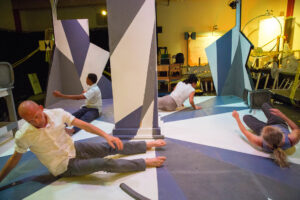In 2016 Craig Harris was commissioned by the dance theater company Off-Leash Area to create a music soundscape for their main stage show AfterWind, produced in July 2016.

Created by Jennifer Ilse & Paul Herwig
Developed with the Cast
Direction/Choreography – Jennifer Ilse
Set – Paul Herwig
Soundscape – Craig Harris
Lighting – Paul Epton
Performed by: Jesse Neumann Peterson, Darrius Strong, Kaori Kenmotsu, Jennifer Ilse, Paul Herwig
This is how Off-Leash Area’s Directors Jennifer Ilse and Paul Herwig describe the show:
AfterWind explores the emotional and psychic repercussions of a terrorist bombing. In the fraught moments after a terrorist attack, death will randomly choose some, while the rest are left to witness unfolding events and wrestle with the most intimate and powerful of fears: our mortality. Immersing the audience in a 360-degree art and dance installation, AfterWind is simultaneously a sensitive meditation on the universal experience of facing our mortality and an examination of the personal, public, and political anxiety that arises from large-scale violence.
Jennifer and Paul posted a fascinating “360” video clip of AfterWind created by V. Paul Virtucio on their web site, where you can see some excerpts from the show, “grab” the screen, and with your cursor drag to a different view of the room. It’s a great way to capture a sense of what it was like to experience the live show in the “surround” setting.
I created a quadraphonic soundscape installation for the show, derived from several hours of field recordings in a variety of settings, including an airport; a government center; an office building; a restaurant; city sounds; movement and verbal sounds captured during rehearsals; and a variety of other sampled and transformed sounds. Each performer employed personalized verbalizations for various parts of the show – expressions of shock; concerns about their future and family members; and hopes/concerns about their funerals.
Here is how reviewers Jay Gabler and Matthew Everett characterized the soundscape:
The performers are largely silent, with the soundtrack provided by a Craig Harris soundscape that may be the real star of the show. Reminiscent of avant-garde tape experiments from the mid-20th century, Harris’s score of rumblings and distant moans is strange and fascinating. … Harris’s sound creates a distinctive experience.
Jay Gabler, City Pages, July 25, 2016
Read Jay Gabler’s full review here.
Craig Harris’ sound design (or, as it’s probably more correctly described in the program, a sound composition) kicks in from the very first moment. The audience and performers are awash in sound from beginning to end. At first with a cacophony of speaking voices blending together, accompanied by an underlying track of common sounds associated with such indoor environments. When the lights (designed by Paul Epton) suddenly shift and an echoing boom suffuses the space, the human voices and normal sounds cut out, replaced by an almost otherworldly soundscape.
Matthew Everett, July 24, 2016
Read Matthew Everett’s full review here.
AfterWind: Past – Coming To
The current sound track illustrates the moment after the “echoing boom” of the explosion. “Coming to” characterizes my interpretation of the victims’ experience as they come back to consciousness, sense their environment and the impact of what has happened, and come to terms with the reality of their situation.
At first the explosion and shock affects the victims’ hearing; they slowly begin to sense the vibrations of their initial verbal expressions. Vibrations gradually evolve, as the tones of the victims’ expressive intonations become audible. Word fragments emerge; words become intelligible; and the beginning of more complete thoughts and phrases reveal their first reactions to their circumstances.
The scene that follows the one depicted here characterizes how the performers respond as they begin to come to terms with the seriousness of their situation, and become aware of the others trapped with them. They experience a combination of deep empathy for their new companions, and the persistent presence of Death Anxiety, a character performed by Paul Herwig.
LANGUAGE ALERT: One character expresses his shock and state of being using a swear word, which may offend some listeners.
AFTERWIND – Present – Death Anxiety
This scene depicts the character “Death Anxiety” in present time, performed by Paul Herwig, and illustrates how authoritarian figures play upon our fears to gain power and control over us. The text includes actual quotations from several authoritarians and dictators throughout history, such as Joseph Goebbles, Marine Le Pen, Adolph Hitler, Benito Mussolini, David Duke, Jason Rapert, as well as quotations from Donald Trump’s 2016 Presidential Election in the United States. The similarity in language and message is remarkable and frightening.
This excerpt illustrates the unfolding of a 6-minute section in a consolidated 2.5-minute excerpt.
Additional soundscape and video clips will be released at a later time.